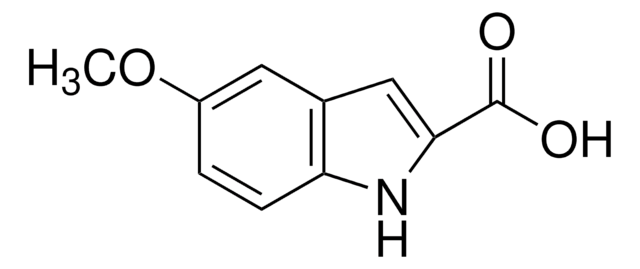265128
5-Fluorindol-2-ca
99%
About This Item
Empfohlene Produkte
Assay
99%
Form
solid
mp (Schmelzpunkt)
259 °C (dec.) (lit.)
SMILES String
OC(=O)c1cc2cc(F)ccc2[nH]1
InChI
1S/C9H6FNO2/c10-6-1-2-7-5(3-6)4-8(11-7)9(12)13/h1-4,11H,(H,12,13)
InChIKey
WTXBRZCVLDTWLP-UHFFFAOYSA-N
Verwandte Kategorien
Allgemeine Beschreibung
Anwendung
- Fungicidal agents
- Antitumor agents
- 2,3-dioxygenase (IDO) inhibitors
- Factor Xa inhibitors
- Enantioselective D3 receptor antagonists
- Ligands for hFPRL1 (or ALXR) receptor in inflammation
- Antibacterial agents
- Inhibitors of hepatitis C virus NS3·4A protease
Signalwort
Warning
H-Sätze
Gefahreneinstufungen
Eye Irrit. 2 - Skin Irrit. 2 - STOT SE 3
Zielorgane
Respiratory system
Lagerklassenschlüssel
11 - Combustible Solids
WGK
WGK 3
Flammpunkt (°F)
Not applicable
Flammpunkt (°C)
Not applicable
Persönliche Schutzausrüstung
dust mask type N95 (US), Eyeshields, Gloves
Analysenzertifikate (COA)
Suchen Sie nach Analysenzertifikate (COA), indem Sie die Lot-/Chargennummer des Produkts eingeben. Lot- und Chargennummern sind auf dem Produktetikett hinter den Wörtern ‘Lot’ oder ‘Batch’ (Lot oder Charge) zu finden.
Besitzen Sie dieses Produkt bereits?
In der Dokumentenbibliothek finden Sie die Dokumentation zu den Produkten, die Sie kürzlich erworben haben.
Unser Team von Wissenschaftlern verfügt über Erfahrung in allen Forschungsbereichen einschließlich Life Science, Materialwissenschaften, chemischer Synthese, Chromatographie, Analytik und vielen mehr..
Setzen Sie sich mit dem technischen Dienst in Verbindung.









